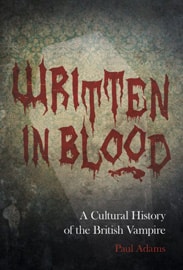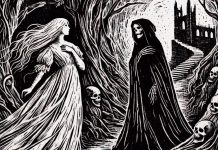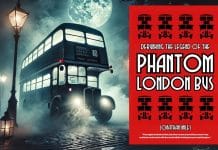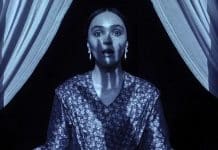PAUL ADAMS, author of Written in Blood: A Cultural History of the British Vampire, looks at the horrific crimes of ‘vampire’ murderer John George Haigh in London during the 1940s
At exactly eight o’clock on Wednesday 10 August 1949, the massive trap doors on the gallows in London’s Wandsworth Prison crashed open, sending the noosed and pinioned prisoner plummeting to his doom.
As hangman Albert Pierrepoint and his assistant Harry Kirk looked down into the pit at the still and silent figure suspended at the end of the long rope, both no doubt had an inkling that they had just executed not only one of the most chilling and ingenious murderers of modern times, but one whose name would become infamous in the annals of British criminal history.
In the weeks and months since his arrest in February the same year, the tabloid press had been filled with sensational headlines about John George Haigh, the ‘Acid Bath Killer’ who claimed to have murdered nine people and disposed of their bodies in a vat of sulphuric acid.
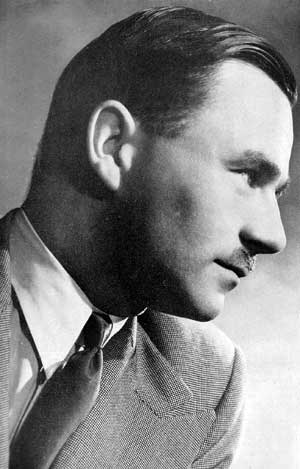
But not only was he a cunning and calculating career criminal who thought nothing of murder to further his financial gains, Haigh also claimed to be a human vampire who drank the blood of his victims before reducing their bodies to sludge.
Haigh had been tried for the murder of wealthy widow, Mrs Olivia Durand-Deacon, who had unknowingly signed her own death warrant after approaching him in London as a possible business partner in her venture to manufacture and market cosmetic fingernails.
A charmer and consummate fraudster, Haigh had invited Mrs Durand-Deacon to accompany him to his ‘factory’ in Crawley, West Sussex, where he claimed he had the means to put her proposition into action.
Haigh’s business premises were in fact a shabby rented outbuilding in Leopold Road where after being shown inside, the 69-year-old woman was shot dead, stripped of her clothing and dumped unceremoniously in a metal drum into which was pumped industrial acid.
Five years before, in September 1944, Haigh had similarly murdered Donald McSwann, the son of a former employer, in a basement room in Kensington, South London, and destroyed the body with acid.
For 10 months he had lived off the dead man’s money before it became necessary to again improve his finances by killing McSwann’s parents, William and Amy, who were brutally disposed of in the same fashion.
In early 1948, Haigh’s incessant gambling and high living made it necessary to kill again.
On 12 February, Dr and Mrs Archibald Henderson were enticed down to Leopold Road and were never seen again.
When he fired William McSwann’s Webley revolver into the back of the unsuspecting Olivia Durand-Deacon’s head a year later, Haigh felt he had established the protocol to commit the perfect crime, but after the widow was reported missing and her jewellery and fur coat were found in his possession, Home Office pathologist Keith Simpson recovered gallstones and an acrylic denture from a mass of slime outside the Crawley warehouse and the charmer was charged with murder.
Shocking motive to John George Haigh murders
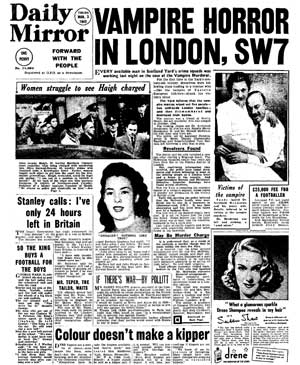
In all these killings, Haigh’s motive was purely for financial gain, but while on remand in Lewes Prison, the murderer claimed there was a darker and wholly more sinister reason for his crimes.
Shocking childhood dreams of forests of bleeding crucifixes and sinister blood-drinking figures had, according to the accounts given to prison psychiatrist Henry Yellowlees, turned the former Wakefield Cathedral chorister into a bloodthirsty maniac who drank the blood of his victims through a straw before consigning them to the acid.
‘I saw a forest of crucifixes which gradually turned into trees,’ Haigh confessed to Dr Yellowless, ‘At first I seemed to see dew or rain running from the branches. But when I came nearer I knew it was blood. All of a sudden the whole forest began to twist about and the trees streamed with blood. Blood ran from the trunks. Blood ran from the branches, all red and shiny. I felt weak and seemed to faint. I saw a man going round the trees gathering blood. When the cup he was holding in his hand was full he came up to me and said “drink”. But I was paralysed. The dream vanished. But I still felt faint and stretched out with all my strength towards the cup.’
According to Haigh, this vision was the catalyst that had led him onto the road of murder.
‘I woke up in a semi-comatose state. I always kept on seeing those hands holding out a cup to me that I couldn’t quite reach, and that terrible thirst, unknown to any other modern man, never left me’.
His strict and austere religious upbringing, with its salvation in the ‘blood of the lamb’, was according to Yellowlees at the core of the ‘paranoid structure’ that Haigh had created for himself.
As well as the Hendersons, the McSwanns and Mrs Durand-Deacon, Haigh claimed that his unnatural bloodlust had forced him to kill three other people from whom he obtained no financial gain, two women from Eastbourne and Hammersmith and a young man named ‘Max’.
Although Haigh’s confessions of blood drinking clearly read like those of a desperate man stressing insanity as a last ditch attempt to avoid the death penalty (he also openly drank his own urine for added shock value), there are some who consider his vampiric status to be a true one.
Writing in his The Vampire in Legend, Fact and Art in the early 1970s, Basil Copper stated in connection with the case: ‘It [Haigh’s vampirism] is something which cannot be proved through the evidence produced during the trial, for there was no evidence, but…after sifting the masses of statements made at the time, there is no doubt in my own mind that Haigh was speaking the truth.’ The killer was, according to Copper, ‘a malformed human being; a vampiric predator whose thirst for blood was slaked on at least six occasions post mortem’.
Not surprisingly, confessions of blood drinking and acid baths gave the popular press a field day.
“Vampire horror in London, SW7” announced the Daily Mirror on its front page for Thursday, 3 March 1949.
‘Every available man in Scotland Yard’s crime squads was working last night on the case of the Vampire Murderer,’ the tabloid announced. ‘For the first time in the Yard’s century-old history, detectives were following clues leading to a maniac who – like the vampire of Eastern European folk-lore – drank his victim’s blood’.
The Mirror’s frenzied baying for Haigh’s own blood eventually resulted in a contempt of court action which saw the newspaper fined £10,000 and its then editor, Silvester Bolam, sent to prison for three months.
The trial proper opened at Lewes Assizes on 18 July 1949 before Mr Justice Humphries; Haigh was defended by Sir David Maxwell Fyfe while Sir Hartley Shawcross appeared for the Crown.
At 4.23 pm on the afternoon of the second day, the jury retired to consider their verdict – they were absent for less than 20 minutes and Haigh was found guilty of the murder of Olivia Durand-Deacon.
While waiting in the condemned cell at Wandsworth, Haigh wrote his memoirs, donated his suit to Madame Tussauds, and enquired as to the possibility of whether he could have a dummy run on the gallows, apparently concerned that his build and ‘springy step’ might give the executioner difficulties.
Today, John George Haigh is known to criminologists and crime buffs alike as the ‘Acid Bath Killer’, but for a few weeks in the spring of 1949, he was quite literally the ‘Vampire of London’.
PAUL ADAMS is a Luton-based paranormal historian, writer and publisher. His latest is Written in Blood, a new examination of vampires and vampirism in British literature, film, music and television together with real-life cases including the Highgate Vampire, the Gorbals Vampire and Stoke-on-Trent’s Vampire of the Villas. Contains in-depth chapters on Stoker’s Dracula, the history of Hammer Films, Gothic and modern vampire literature and vampire-related murderers. Publication date is 1st July 2014 and can be pre-ordered from Amazon. He has written several other books on British ghosts and hauntings including Borley Rectory. Find out more at pauladamsauthor.co.uk Follow him @pauladamsauthor


